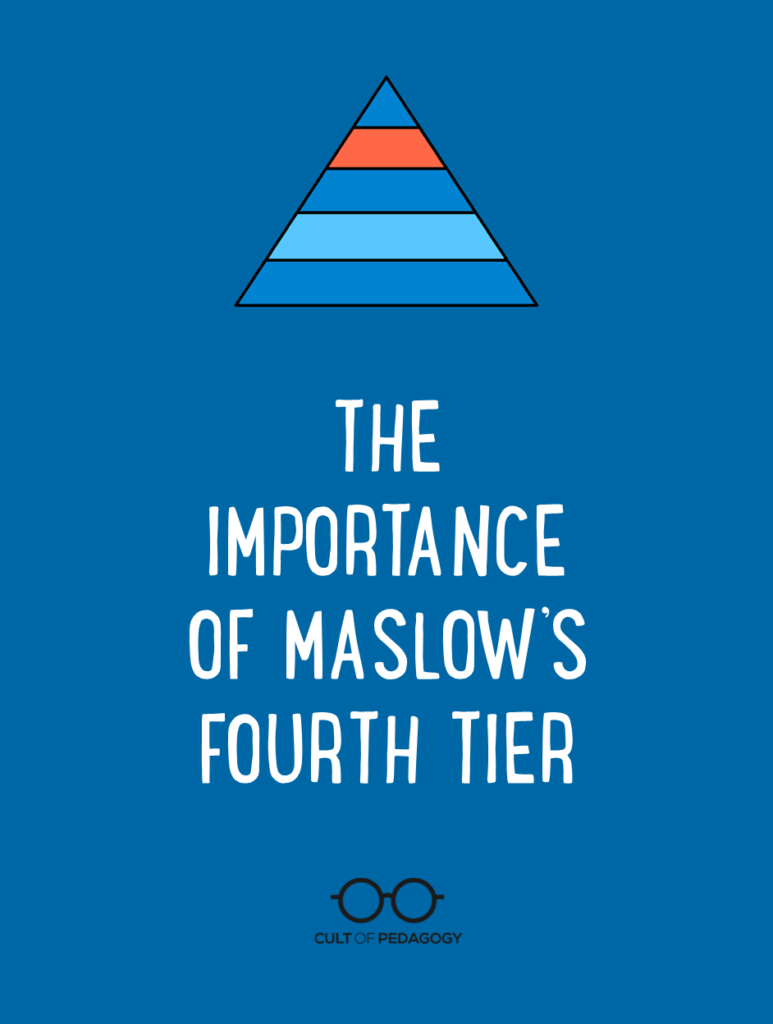
Listen to the interview with Connie Hamilton:
Sponsored by Today by Studyo and Scholastic Scope
This post contains Amazon Affiliate links. When you make a purchase through these links,
Cult of Pedagogy gets a small percentage of the sale at no extra cost to you.
I wish, in my early career, I understood why some students tried so hard to impress their friends. I recall the faces and circumstances of specific students throughout my career when students’ actions just didn’t make sense. Instead, I presumed they were simply exhibiting “attention-seeking behavior.” My antidote was to shower them with positive attention when they did something good. My hope was that the recognition I provided fulfilled their need to be affirmed, elevated their status in my classroom, and would reduce their urge to blurt out unrelated and sometimes ridiculous comments just to get a laugh.
The problem was, I was only half correct with my amateur diagnosis of student behavior. I was on the right track to recognize it as an esteem issue. However, what I missed completely is how and why esteem needs cause students to act in ways that defy what they know as right, to ignore their own strengths and accomplishments, and to restrict their success as a learner.
Some educators blamed social media. When I taught middle school, it was often labeled a trait of the age group. It wasn’t until recently, when I was revisiting Maslow’s Hierarchy, that the lightbulb turned on. Not only did it click, I think it busted the glass with what I had overlooked for so many years. The need to meet the fourth tier in the hierarchy—esteem—is more significant than I had realized. If we can better understand how this tier works, we can help our students satisfy their esteem needs in healthy and beneficial ways.
Editor’s note: Since the publication of this post, it has been brought to our attention that Maslow built his hierarchy with significant, but uncredited, influence from the Blackfoot Nation. While this fact does not negate anything written here, it is a history all educators should know. Learn more about the background and the significant differences between the two models in this collection.
How Maslow’s Theory Impacts Learning
In order to motivate students to achieve and be willing to take risks, we have to understand the needs humans have that impact their ability to tap into that motivation. According to Maslow’s original hierarchy, there are five tiers that make up a hierarchy of needs (Maslow, 1987).
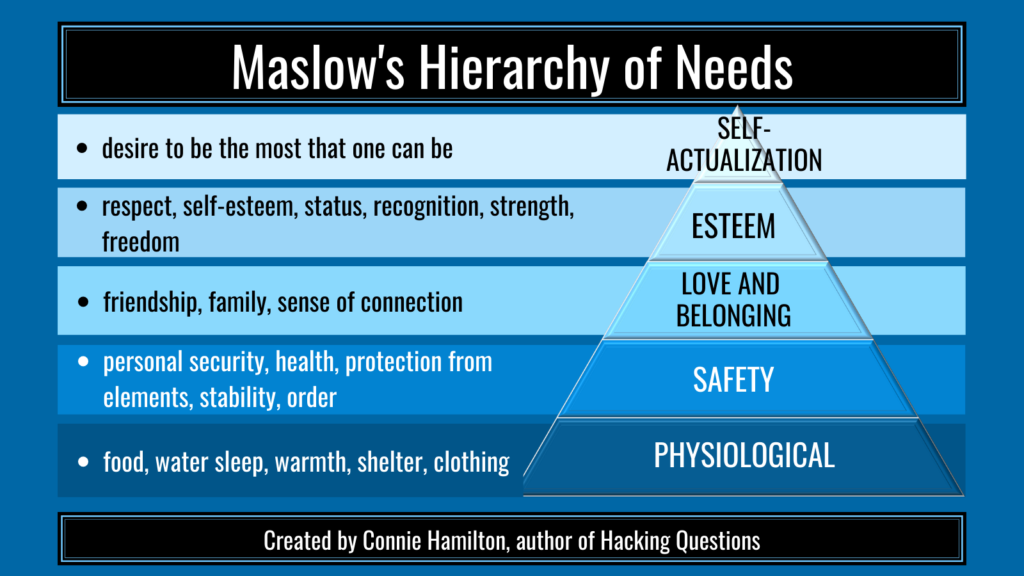
Deficiency vs. Growth Needs
In the first four stages—physiological, safety, love and belonging, and esteem—Maslow says that we don’t feel anything when these needs are met, but anxiety kicks in when they are not. For example, if you’ve had a good meal, there isn’t a boost of motivation, but hunger can impede a person’s ability to concentrate. He calls these deficiency needs. His theory is that when we are craving physiological, safety, belonging, and esteem needs, we become distressed. There is a negative impact when we are deprived of these needs, but no impact when they are met; we simply avoid unpleasant feelings or responses. (Maslow, 1962).
The top tier of Maslow’s Pyramid is where behavior and motivation turn. The fifth stage is self-actualization. Self-actualization is the lone motivator that Maslow labels as a growth need. This means that the energy that is presented as anxiety when seeking fulfillment at the lower four levels converts to actions to improve oneself at the top level.
How the First Three Tiers Play Out in School
Tier 1: Physiological Needs
Without these biological and basic needs, the body can not function at its best. These foundational needs (air, food, clothing, warmth, sleep, etc) were determined by Maslow to be most important, causing the other stages to be secondary until these basic needs are met.
It is more important than ever to remember how powerful these physiological needs are. Students who are hungry and sleep-deprived are not cognitively open to learning. It’s not that they choose not to learn; their brains and bodies simply make it extremely difficult to do so.
Tier 2: Safety Needs
Take a hard look at the list of examples that fall under the stage of safety. Protection from elements, security, order, law, stability, freedom from fear. This means predictability, control in their lives, emotional security, and social stability are all impacted in this area.
Family and schools are among the entities that fulfill these safety needs. When K-12 education—a major source of stability for students—is not consistent, predictable, and routine, it leaves students unfulfilled. For example, when schools are faced with a sudden need to change from in-person to virtual, it significantly disrupts the comfort a regimen provides. Established school and classroom routines play a role in students’ feelings of safety at this level.
Tier 3: Love and Belonging Needs
Once the physiological and safety needs are met, the next stage concentrates on social interactions and a feeling of belonging. This is more about lack of exclusion and avoiding isolation than it is about status. (The level of clout is more directly connected to the 4th stage, esteem.)
Besides their families, students often experience feelings of belonging at school. Classroom families, friendship groups, clubs, and sports teams all offer the sense of being part of a group. Students who are missing love and belonging in their home lives can get some of these needs met in the educational and social settings. We accomplish this through seating arrangements, peer partner groups, an overall sense of caring and compassion, and taking interest in students outside their identity as a learner.
The Fourth Tier: The Truth About Esteem Needs
Here’s where many of our assumptions about student motivation are debunked when Maslow’s theory is applied. It is logical that warm clothes, a desire for stability, and even a sense of love and belonging are all deficiency needs. A common misconception is that esteem belongs with self-actualization in that they both drive improvement of oneself. While this is true for self-actualization, esteem is a deficit need. This means the motivation is triggered by negative feelings that lack of esteem generates.
Maslow identifies two categories within the esteem stage: (1) esteem for oneself or self-esteem, and (2) esteem from others (Maslow, 1987). It is the second type that includes reputation and respect from others that he claims is most important for children and adolescents. The desire for respect is established before true self-esteem is developed (McLeod, 2020).
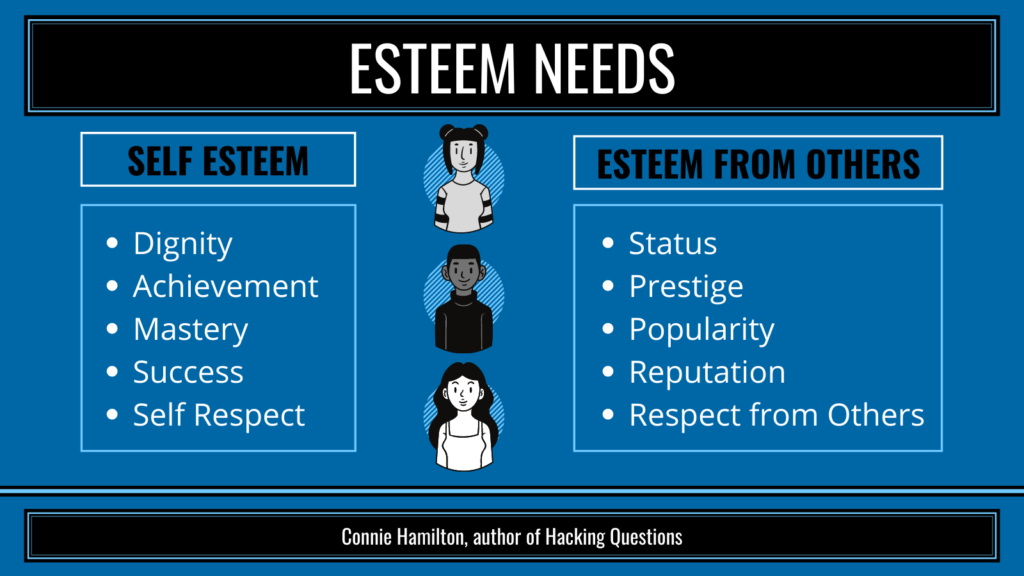
The need to be respected by others plays a direct role in students’ willingness to take risks in the classroom. If a student’s status is vulnerable, they are less likely to engage in activities that will prevent their esteem needs from being met. However, students who have established reputations with their peers can bounce back from an event that could otherwise lower their social status.
We often recognize when students care more about what others think about them than their own success. This is the esteem stage we are noticing. Adults often try to divert children’s attention from their need for respect from others to being content with themselves. The result is not overwhelmingly effective because the desire to be accepted by others precedes the self confidence kids have. This, according to Maslow, is not a chicken-egg scenario.
Here’s the tricky part about meeting esteem needs: They can’t be faked. False praise and inflated achievements don’t contribute to a student’s self-esteem or improve their reputation with others. Because esteem is aligned with the internal feelings people have about themselves, when participation trophies, for example, are given, the recipients have an underlying awareness that the trophy wasn’t actually earned. So, while the positive attention is welcomed, it doesn’t positively impact the confidence people have in themselves. It can actually work in the opposite way because it calls attention to a lack of true success which can lower people’s beliefs that they’re worthy or capable (Kay & Shipman, 2018).
When intentionally working to address the esteem needs of our students, we have to provide authentic experiences of knowledge, competence, independence, recognition, and confidence. Even though esteem is an internal quality, it relies on external experiences to reinforce or build it. In their book, The Confidence Code, authors Kay and Shipman explain that confidence—a close cousin to esteem—is grown by overcoming challenges. They share that failing fast, then using the lessons learned from those initial failures to eventually achieve success, is one of ways confidence is built. If success is not ultimately achieved, and in a genuine way, then the person is simply left with a feeling of failure and you can easily guess what that does to esteem. The formula is challenge + success (no matter how long it takes) = confidence increase (Kay & Shipman, 2018).
When success seems to be a stretch, then the teacher’s focus should move to reducing the negative impact a classroom event has on damaging esteem. Strategies like “phone a friend” have that potential. If students are asked to provide a response and when invited to get help from a peer the question then transfers to the peer, the initial student sees the opportunity for a status boost handed off to a classmate. However, if the initial student asked was provided the choice to solicit a prompt or hint from that classmate, the original student maintains the feeling of success. One giant step to building esteem in our learning spaces would be to reduce the emphasis we place on right answers. It encourages cheating at every stage of the learning process. When students feel they should know the answers from the onset of a lesson, they engage in efforts that do not promote building their knowledge (an esteem booster) but rather, reinforce a feeling of incompetence (an esteem buster).
3 Esteem-Building Strategies to Try
In my observations of hundreds of lessons across the nation, the following strategies have an impact on the willingness students have to take risks when faced with a challenge and therefore, present the opportunity to truly pump up esteem. As Kay and Shipman point out, lack of trying guarantees confidence will not rise (2018).
1. Give students an “out” up front.
Offer students specific language that allows them to “under-commit” to responses or give them an opportunity to save face. It’s much easier to shift or back away from an answer if it was prefaced with something like, “I might change my mind later, but right now I’m thinking…” versus “I think the answer is …”
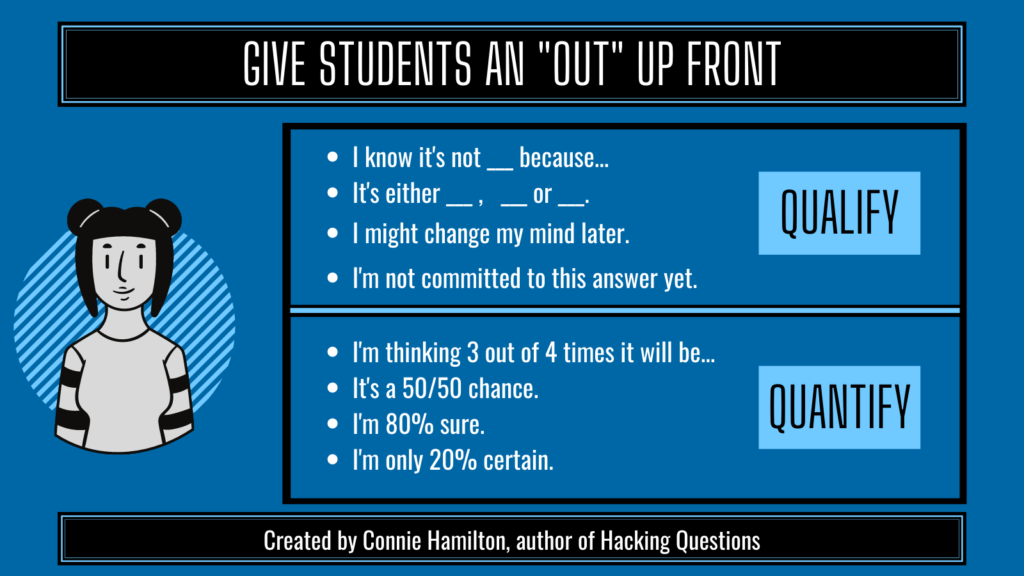
2. Listen for opportunities to elevate a student’s status.
When you’re intentionally trying to fulfill students’ esteem needs and you’re not seeing opportunities, create them. You can solicit affirmations from your students by calling attention to contributions they bring to the class. Then, when you recognize an example of one or more students impacted positively by something a peer said/did, narrate it to call attention to it. These two actions, soliciting opportunities and labeling make for a solid pairing. Solicit positive peer comments, then label them as such.
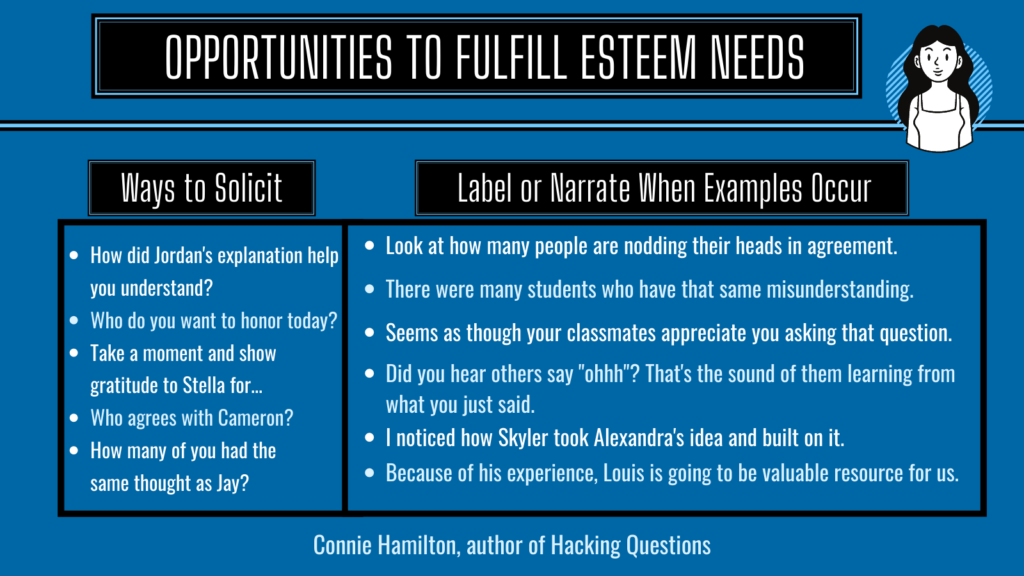
3. Support Positive Peer Interactions.
Classroom culture and structures can also be used to encourage ways to support positive peer interactions to fulfill esteem needs. Planning ways to fulfill the esteem needs of your students, the results will be quicker and stronger than if you wait for them to happen organically.
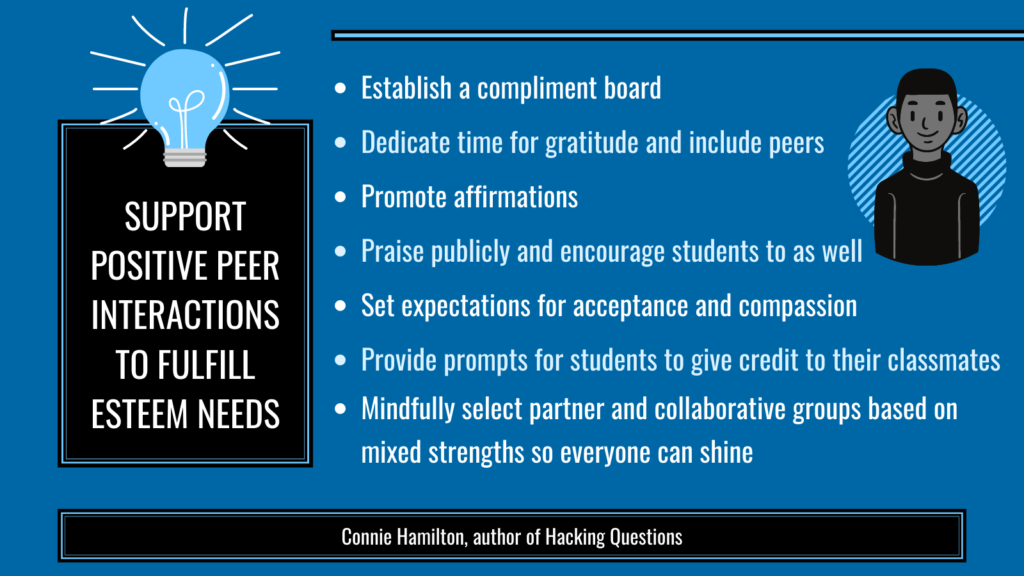
Moving to Tier 5: Self-Actualization Needs
Students in this stage seek opportunities to grow. Examples include creative thinking, contributing to a greater good, self assessment, and independent goal setting. The forces that feed self actualization, the only growth need on the hierarchy, come from within the individual. This is distinctly different from the deficiency needs that come from external forces. For students who appear to be self actualizing, they will thrive in environments that provide autonomy, self expression and creativity.
Attending to the hierarchical needs of our students will help us provide a safe learning environment. A place where their basic needs are met, they have a sense of safety, and they feel they belong is necessary. Attention to their esteem needs will create a classroom where students do not fear losing status or triggering their need to protect their own self esteem. These levels are deficiency needs; when they are not satisfied, students experience negative emotions that can drive their actions and impact behavior. Rather than addressing the behavior as if the student is trying to elevate their esteem, seek ways to satisfy their need to be valued and respected. You will have more luck making a long-lasting change and a positive impact on the young humans in your classroom.
References
Kay, K., & Shipman, C. (2018). The confidence code: the science and art of self-assurance– what women should know. HarperBusiness, an imprint of Harper Collins Publishers.
Maslow, A. H. (1967). A Theory of Metamotivation : the Biological Rooting of the Value-Life. Journal of Humanistic Psychology, 7(2), 93–127. https://doi.org/10.1177/002216786700700201
Maslow, A. H. (1987). Motivation and personality (3rd ed.). Harper & Row Publishers.
McLeod, S. (2020, December 29). Maslow’s Hierarchy of Needs. Simply Psychology. https://www.simplypsychology.org/maslow.html
Join our mailing list and get weekly tips, tools, and inspiration that will make your teaching more effective and fun. You’ll get access to our members-only library of free downloads, including 20 Ways to Cut Your Grading Time in Half, the e-booklet that has helped thousands of teachers save time on grading. Over 50,000 teachers have already joined—come on in.

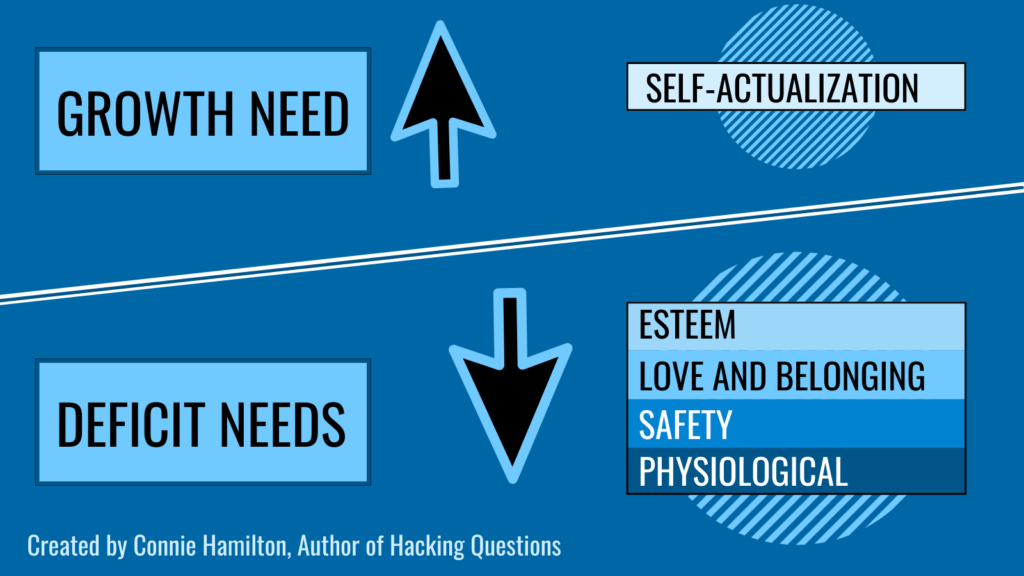




I usually don’t comment on things but this article is inspirational. I didn’t think of “attention-seeking behaviors” as a response to a need. I wish I could go back in time and undo some of my reactions to those students who just wanted to maintain their status among their peers. Wow. I asked myself: Did I have any students functioning at Tier 5 in my classroom? Did I give students the opportunity to grow emotionally? Hmmmm. There were some really great ideas about allowing students to “opt out”! I loved that! I can see that next year will be better! Thanks!
I went through the same type of reflection as you described when I was formulating this “aha”.
Awesome information. I have been saying this for years as a survivor of Childood abuse and neglect.
“Every time you think of calling a kid ‘attention-seeking’ this year, consider changing it to ‘connection-seeking’ and see how your perspective changes.”
~Dr. Jody Carrington, psychologist
I love this, Dr Carrington! Thanks for sharing that easy flip.
@Janet there is a part where student need boundaries. If a student blurts out in your class it is attention seeking (or as you call it connection seeking). There needs to be consequences and clear boundaries in addition to providing a connection.
I would be horrified if a kid interrupted you and you just let them because your perspective is they want to “connect”.
Set CLEAR BOUNDARIES 🙂
Zac,
I think when referencing “any” seeking behavior, the perspective, whether for attention or connection is for us to have. If we position the blurt as being disruptive, we are more likely to frame it as a discipline or management issue. When it’s viewed as a desire to connect or elevate esteem, we might be more inclined to address the behavior through a compassionate lens.
In either case, if behavior is undesired I would agree it should be addressed. If we wish to prevent the behavior in a compassionate way, we will likely have more success if we address the root cause. In this situation, if the root cause is to feel a sense of belonging, then if we intentionally make an effort to be inclusive, the behavior could be avoided.
I can’t imagine any teacher labeling undesired behavior as “thanks for seeking attention” or “thanks for seeing connection”. It’s more about a way we frame our thinking when we address it from a lens of understanding (not blatant acceptance).
Thank you so much for this information. I was particularly struck by the podcast discussion around mindfully selecting collaboration groups so that students can shine. Although it’s not mentioned in the post itself, Connie Hamilton discussed her strategy for choosing students who might otherwise not have opportunities to shine and providing them important information that they can go back and share with their groups, thus giving authentic esteem building interactions. This is very reminiscent of BeGLAD’s use of expert groups which is like a jigsaw, but it scaffolds students in heterogeneous groups to access complex grade level texts. For some students it is the the first time they have accessed grade level text successfully and this allows them to disseminate learned info to their team. I think it fits right in with Connie’s observation that challenge+success=confidence.
While BeGLAD strategies are often used in elementary school, I have really enjoyed using them in middle and high school for the past five years. I find that expert groups not only give students important information to share but enable them to do so in a highly supported manner.
Kelly,
Thanks for sharing about BeGLAD. I agree that jigsaws with expert groups are effective strategies for empowering students as leaders and sources of information for their peers.
As a matter of fact, Jenn writes about 4 Thinks You Don’t Know About the Jigsaw Method here: https://www.cultofpedagogy.com/jigsaw-teaching-strategy/
Can you please elaborate a bit more about tier 2 and what you mean by Protection from elements, security, order, law, stability, freedom from fear.
How are these seen?
We have modern learning environments with around 110-120 students in one learning space.
They don’t have freedom of fear when there are multiple violent students in their learning space who are violent almost every day.
How would you see security, order and law playing out? We have very little boundaries in place and no consequences for attacking other children or adults making the other children frightened.
Maslow’s theory is generally that a person’s motivation will lie with the lowest level of unmet need. So, in your case, if students feel there is danger of harm, their energy will focus on keeping themselves safe.
If the deficiency need is not mostly satisfied, they are unlikely to take much interest in the higher levels. For example, when you fear for your safety, you’re not likely to be concerned with whether if not the people presenting a threat think you are smart or good looking – unless it protects you from harm.
A more common situation is how people get “hangry”. When hunger needs are not met (Tier 1: physiological need) the focus is on food and being kind to others and make friends (tier 3: love and belonging need) is temporarily paused.
The motivation to achieve higher levels is present when the lower levels are mostly satisfied. Therefore, based on Maslow’s theory, you will have a challenge to achieve a sense of community, build esteem or have many students take on learning challenges. Their ability to work to fulfill higher levels will often be superseded by their need to be free from fear.
This podcast has given me a huge “aha” moment- thank you for that. I realize now the importance of addressing the third tier- absence of belonging, especially after the extreme isolation of the last year. It’s an interesting lens through which to view the SEL framework that my school has planned for this upcoming year. I would love to hear/read your thoughts on addressing the third tier, beyond clubs, teams, and cliques.
Erin,
Thanks for your question. Love and belonging is, as you suggested, more than just being a member of a club. It’s the overall feeling like you fit in. Students from historically marginalized groups, particularly in a predominantly white school might not immediately feel like they “belong” in the class. So, the efforts the teacher makes to be inclusive, honor each student, and be sure that voices are amplified are key.
Greeting students at the door, welcoming them in, getting to know their interests, addressing actions that alienate students, building a positive culture of acceptance and appreciation all attribute to belonging. I think of collaborative groups of peers when we connect through laughter, communication, and collective growth. These are professional groups where I feel like I am “at home” so to speak.
Conversely, I can “belong” to an organization because I paid my dues, but I might go to a conference and don’t feel welcomed or valued, I might not feel like I belong, even though my membership card says otherwise.
Is it possible for you to give an example of this?
2. LISTEN FOR OPPORTUNITIES TO ELEVATE A STUDENT’S STATUS. When you’re intentionally trying to fulfill students’ esteem needs and you’re not seeing opportunities, create them. You can solicit affirmations from your students by calling attention to contributions they bring to the class. Then, when you recognize an example of one or more students impacted positively by something a peer said/did, narrate it to call attention to it. These two actions, soliciting opportunities and labeling make for a solid pairing. Solicit positive peer comments, then label them as such.
Hi Andrew, there’s a graphic below the paragraph you cited that gives some examples of how to solicit affirmations from students. Scroll down and you’ll see it. Let us know if you have any further questions!
Great article! Thank you so much for acknowledging the influence of the Blackfoot nation!
I fully agree with your post. I have been teaching for only 10 years and it’s taken some time to feel like I’ve made progress understanding the minds of students. Understanding child psychology is paramount if we’re ever going to close the education gap. That’s just step one, understanding. Next, creating situations for self-actualization need to be a part of not just the education process but infused in our cultural, or even more basic, our human identity. Capitalism and popular media continue to dissuade kids especially from using logic and wisdom to challenge their primal desires, unless it means larger profits. In my opinion, there is a blatant disconnect between what we teach and what is really driving success in some industries. More unity in an honest, ethical America is required to reach all students and help them self-actualize in a way that earns an A.
I found this article to be incredibly insightful. I am going to be student teaching in the fall and one of my biggest worries is how I will manage my classroom. This article helped me to frame how I consider unruly students much better. Instead of seeing them as distractions and disruptions, I now will strive to see where they may not feel as confident. Perhaps it is just school in general or it is something more specific like reading. Regardless, seeking to build students’ esteem rather than tearing it down is something I need to be better at. I am grateful for this article inspiring me to be a better teacher.
Thanks for sharing your insight, Jeremy. If nothing else, it helps us to approach management from a place of compassion rather than an execution of power.
Thank you for acknowledging the influence of the Blackfoot Nation. I was unaware and will do so accordingly from now on.
Hi Connie,
This post really made me reflect on my own responses to disruptive students and whether I provide students opportunities to affirm their peers. The examples you gave to support student success (getting a hint rather than passing) really highlights the minor points that create a huge difference in student self-esteem and self-worth. This will definitely help me be more mindful going into the next school year.
Something we do in my sports club is choose an athlete of the night and highlight what they did really well, do you think this is something that would also work in the classroom? Should this be something the teacher does, or would it be worthwhile to have a student choose someone to highlight and maybe keep the chain going where the person highlighted yesterday highlights someone today. I’d like to know your thoughts on this!
Thanks!
Tai, based on the post I think that both a student-driven approach and a teacher-driven approach are valid. In section 2. Listen for Opportunities to Elevate a Student’s Status, Connie suggests both soliciting positive peer comments (student-driven) and narrating examples of positive impact to call attention to them (teacher-driven). Similarly, the graphic in section 3. Support Positive Peer Interactions lists both student-driven strategies, like establishing a compliment board, and teacher-driven strategies, like praising students publicly. I think your idea would align nicely with the principles in this post regardless of which approach you take!
Well said, Margaret.
Tai,
I love your idea of elevating individual students. As you apply this process, I encourage you to be mindful of how genuine the comments are. I have seen “student of the week” activities that intend to celebrate students and it becomes surface level.
A key point of addressing esteem is that it has to be real. Disingenuous or artificially inflating compliments work in reverse. I say read your group, if you think it will work, give it a try. If you notice people are going through the motions and it isn’t having the depth of impact, look for ways to modify it. For example, if every week the same compliments are provided “You’re nice. You’re nice. You’re nice, too.”
Here are some ideas to keep in your back pocket if you need them:
1. Instead of having everyone “say something” about the one athlete or student, take volunteers. If there are 6 hands in the air, maybe give the floor to a strategic 4 of them, then close with “there are still more people who want to celebrate you.” or something similar that will leave them with the feeling that there are more as opposed to there were only 6 people who had something to share.
2. Offer it in writing. Consider naming the author or leaving it anonymous depending on what works best for your students.
3. I’ve seen some teachers open a time for gratitude and it isn’t showered upon a single student but more about giving shout outs to anybody. In this case, it’s helpful to keep a side tally of who is acknowledged and more importantly – who is NOT. Then seek ways to equalize the recognitions.
4. The teacher can model and maybe even spend a couple minutes talking about meaningful praise. What feels better: “You’re smart.” or “You help me understand when I’m confused.”
5. I’ve never tried this (so if you do, let me know if it works), but I was just thinking, what if some characteristics were on cards and students looked to use them to describe their classmates? This might get away from general compliments and enhance SEL vocabulary at the same time. Think words like: helpful, considerate, thoughtful, selfless, honorable…
I really like what you are saying here, it resonates but it seems like from what I’ve read that the evidence in support of Maslow’s theory is light. Not just the hierarchy but whether these are really universal needs and I am just curious about your thoughts on this? Like learning styles, recent research suggests the theory has little evidence behind it.
Laurie,
You’re right. Maslow’s theories are widely disputed. One example that many of us can relate to is the love a parent has for a child. They might sacrifice their own needs (even food, safety, love) for the sake of their child.
That said, there is research that links esteem to student success. (Here is one: https://www.apa.org/ed/schools/primer/self-esteem#:~:text=Self%2Desteem%20and%20perceived%20competence,take%20appropriate%20academic%20growth%20risks)
Esteem of self and esteem from others also extends beyond Maslow. Since posting this blog, over a year ago, I’ve been reading more about “other esteem” through the psychological lens.
Connie,
Thank you for this article! It’s very helpful to me as I have quite a few students who could benefit from the suggestions here. I am in my fifth year of being an elementary specialist, so my students are all the students in the school whom I see for 45 minutes each week. I don’t have the luxury of building the same kind of relationship with my students that classroom teachers have, but I do what I can to build a spirit of belonging and connection in my classes. Some classes are more difficult than others, some having students like the ones you describe who crave attention. One student came to mind as I read your article. As long as I’ve know them, they have sought attention from others, but the behavior has intensified following a horrific tragedy in the family. My heart breaks for them, and I find myself at a loss as to how to deal with the behavior. I know that peer approval means a great deal to them, yet their actions are alienating peers. Your article gives me a good deal to think about. Do you have any specific advice for dealing with tragedy? Thanks again!
Tanya,
It sounds like your student has some things impacting him that go beyond esteem. Here is a free resource that I found helpful to give some background information about trauma: https://www.crisisprevention.com/CPI/media/Media/download/PDF_ETIC.pdf?_gl=1*tyc1bx*_gcl_aw*R0NMLjE2NjU4ODI0NjcuQ2p3S0NBand0S21hQmhCTUVpd0F5SU51d0ZvT1NUUFpOeWpDd05vNkxJMnV6NWN2TmNFaElSUll6VFZocHhmdDFzX3FVRkJONEZzRk1ob0N6X1lRQXZEX0J3RQ..
Another resource is this ASCD article: https://www.ascd.org/el/articles/trauma-informed-teaching-strategies
Hi Connie,
I really loved listening to the podcast and reading through your blog! Before I decided to become an English teacher, I was majoring in psychology and it continues to fascinate me that the two connect so much! When I am working with students I try to meet them where they are at and form positive connections with them and their families. I loved your bit about including things every student feels comfortable doing by providing examples but allowing them to grow from there if they feel ready. Maslow’s hierarchy of needs certainly comes into play in a school setting, especially since students spend so many hours of their day in our classrooms. It is crucial for them to feel accepted and seen in every class, and you really highlight the importance of this.
Thank you so much for highlighting this tier. I think that so many teachers can get caught up in focusing on the lower tiers and not always know how to assist students in the esteem tier. This was a great read that should be incorporated at teacher professional developments.
Thanks for this, Heather! Jenn will be so glad to know that you find the post valuable.
I really enjoyed reading this! I am currently in a teacher preparation program at the University of Michigan and hopefully will be in a classroom in the next year. My goal is to build a supportive learning environment and this post has helped answer a few questions that have been kicking around in my head since I started with placements. In addition I was the attention seeking student once upon a time so I can relate and empathize with the identification esteem as a deficit need according to Maslow’s Hierarchy of Needs. I thought the three suggestions will be useful for me to implement and I have seen some of them in practice. The giving an “out” to a student and offering opportunities to gain recognition were both techniques I witnessed my mentor teacher use in action. Recognition is the beginning of esteem, to be “seen” by others allows us to see ourselves. Hopefully I can mirror this and become a supportive aspect of my students lives.
Hi Nick,
Thanks for reading! Jenn will be happy to hear you found the post useful.
This was a great article to read. Thanks for sharing. I also enjoyed the talk on deficiency in the interview and the analogy of being hungry. I definitely have a different thought “attention seeking children”. Thanks again
Thanks for reading, Stephania!